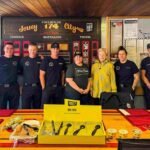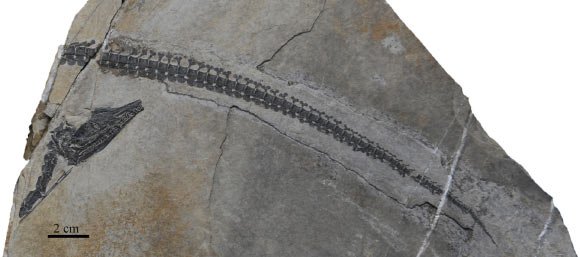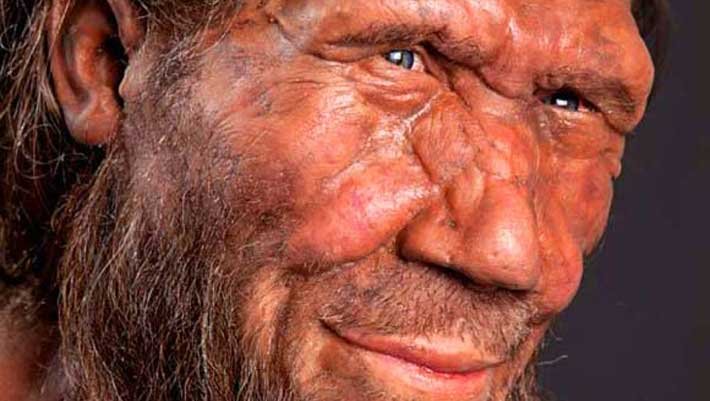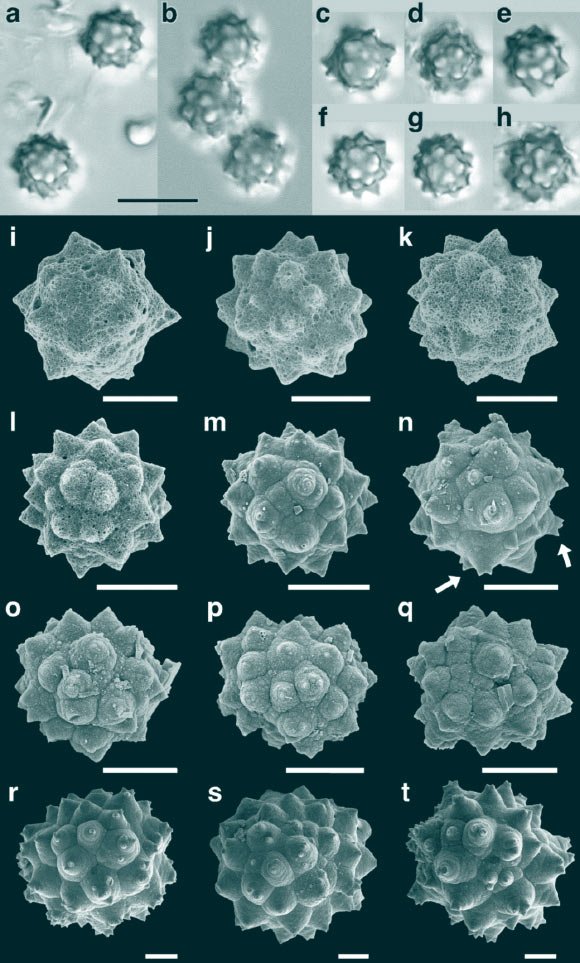Paleontologists have identified a new genus and species of small-sized dinocephalosaurid archosauromorph from the fossilized skeleton found in the Chinese province of Yunnan.

Holotype of Austronaga minuta discovered from Luoping, Yunnan, China, with the skull, anterior cervical vertebrae, and most of the caudal vertebrae preserved on a block. Image credit: Wang et al., doi: 10.19615/j.cnki.2096-9899.231013.
Austronaga minuta inhabited the Tethys Ocean during the Middle Triassic period, some 244 million years ago.
The new species is an archosauromorph, a member of a group that includes all of the forms more closely related to archosaurs (such as crocodilians and dinosaurs) than to lepidosaurs.
The ancient reptile is the sister species of Dinocephalosaurus orientalis, another remarkable marine reptile from the Middle Triassic of China.
“The Middle Triassic of southern China has yielded remarkable marine vertebrate assemblages that are drastically changing our understanding of the biotas of the Tethys Sea and its shorelines,” said Dr. Wei Wang and colleagues from the Institute of Vertebrate Paleontology and Paleoanthropology and the Luoping Biota National Geopark.
“A group of Triassic non-archosauriform archosauromorphs take a prominent place among these discoveries.”
“They were traditionally termed Protorosauria or protorosaurs but are now considered as a paraphyletic group.”
“One species belonging to this group of reptiles, Dinocephalosaurus orientalis, is one of the most intriguing reptiles discovered in recent years from the Triassic of southern China,” they added.
“Its greatly elongated neck recalls a similar condition as seen in another aquatic archosauromorph, Tanystropheus.”
“Both species possess a neck that is more than twice as long as the trunk.”
“The new non-crocopodan archosauromorph from Yunnan shares many features with Dinocephalosaurus and together with the latter are distinguishable from other long-necked archosauromorphs.”
“However, this new species also exhibits many anatomical features different from Dinocephalosaurus, and therefore a new genus and species are suggested for it.”
A small-sized but skeletally mature specimen of Austronaga minuta was recovered from the Guanling Formation at Waina village in Yunnan province, southwestern China.
“The specimen includes an almost complete, albeit greatly compressed, skull, the anterior part of the neck in articulation with the skull, and most of the tail of approximately 60 caudal vertebrae,” the paleontologists said.
Their phylogenetic analysis shows that Austronaga minuta together with Dinocephalosaurus and Pectodens form a clade representing the archosauromorph family Dinocephalosauridae.
The new marine reptile likely had an aquatic or semi-aquatic lifestyle.
“The dentition of Austronaga is less specialized than that of Tanystropheus and Dinocephalosaurus, yet it possesses some enlarged teeth as in these species, which corresponds to a likely diet of small aquatic animals like fishes and cephalopods,” the researchers said.
“Other potential indicators for aquatic locomotion come from the tail of Austronaga.”
“Elaborate structures on caudal neural spines and chevrons are only observed in Austronaga and Dinocephalosaurus among these non-crocopodan archosauromorphs.”
“These structures on the tail are not essential for aquatic propulsion considering their absence in other aquatic reptiles and even in several aquatic lineages.”
“Nevertheless, a similar morphology is convergently present in many aquatic reptiles. For example, plate-like caudal neural spines are developed in the basal ichthyosaurs, Sclerocormus and Chaohusaurus.”
“T-shaped chevrons are found in the enigmatic sauropterygiform Atopodentatus, and in the primitive placodonts Paraplacodus and Placodus.”
“Therefore, we consider the morphology of the caudal vertebrae in Austronaga to correspond to an aquatic or at least semi-aquatic animal.”
The discovery is reported in a paper in the journal Vertebrata PalAsiatica.
_____
W. Wang et al. 2024. A small-sized dinocephalosaurid archosauromorph from the Middle Triassic of Yunnan, southwestern China. Vertebrata PalAsiatica 62 (1): 13-32; doi: 10.19615/j.cnki.2096-9899.231013











